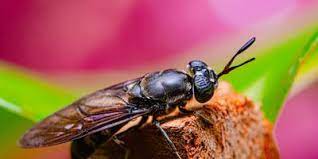
Dead flies could be turned into biodegradable plastic, researchers have said.
The finding, presented at the autumn meeting of the American Chemical Society (ACS), could be useful as it is difficult to find sources for biodegradable polymers that do not have other competing uses.
“For 20 years, my group has been developing methods to transform natural products – such as glucose obtained from sugar cane or trees – into degradable, digestible polymers that don’t persist in the environment,” said the principal investigator, Karen Wooley, from Texas A&M University.
“But those natural products are harvested from resources that are also used for food, fuel, construction and transportation.”
A colleague suggested she could use waste products left over from farming black soldier flies. The larvae of the flies contain proteins and other nutritious compounds so are being raised for animal feed, and they break down waste so are being bred for that, too. However, adult flies are less useful and are discarded after their short life span. Wooley’s team has been trying to use these carcasses to make useful materials from a waste product.
The researchers found that chitin, a sugar-based polymer, is a major component of the flies and it strengthens the shell, or exoskeleton, of insects and crustaceans. Shrimp and crab shells are already used for chitin extraction. Researchers said the fly-sourced chitin powder seemed purer than that from crustaceans and obtaining chitin from flies could avoid concerns over some seafood allergies.
From the fly products, the team created a hydrogel that can absorb 47 times its weight in water in just one minute. This product could be used in cropland soil to capture flood water and then slowly release moisture during droughts.
Wooley said: “Here in Texas, we’re constantly either in a flood or drought situation, so I’ve been trying to think of how we can make a superabsorbent hydrogel that could address this.”
The scientists hope they will soon be able to create bioplastics such as polycarbonates or polyurethanes, which are traditionally made from petrochemicals, from the flies. These plastics will not contribute to the plastic pollution problem.
Wooley said: “Ultimately, we’d like the insects to eat the waste plastic as their food source, and then we would harvest them again and collect their components to make new plastics. So the insects would not only be the source, but they would also then consume the discarded plastics.”






